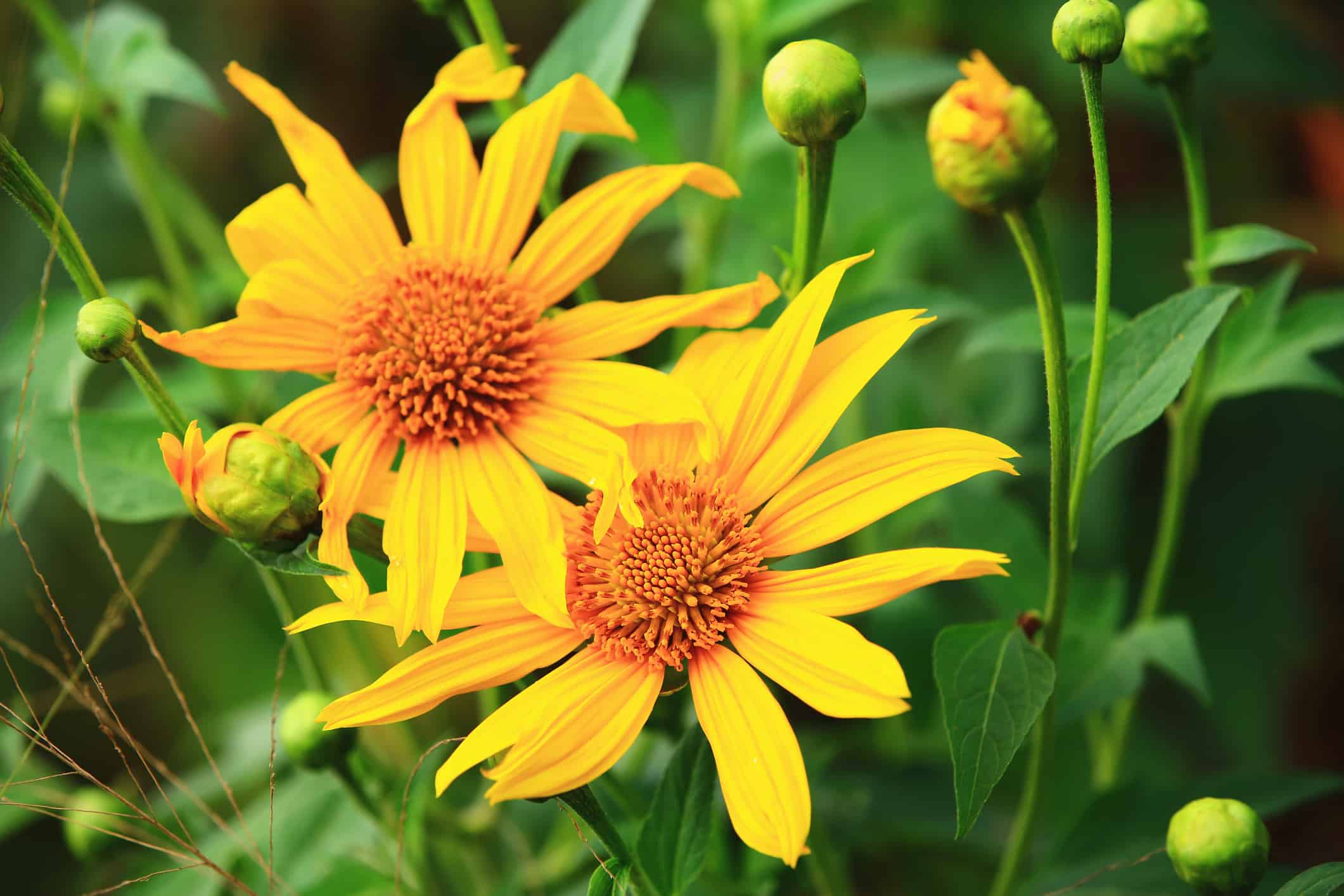Embrace the vibrant beauty of Colorado’s diverse landscapes by planting the perfect flowers that thrive in this Rocky Mountain state. From the towering peaks of the Rockies to the serene plains and high desert regions, Colorado offers a unique canvas for gardeners to paint with nature’s colors. In this article, we’ll explore the best flowers to plant in Colorado, providing you with a comprehensive guide to elevate your garden’s charm. Let’s look at some of the best Colorado flowers!
1. Columbine
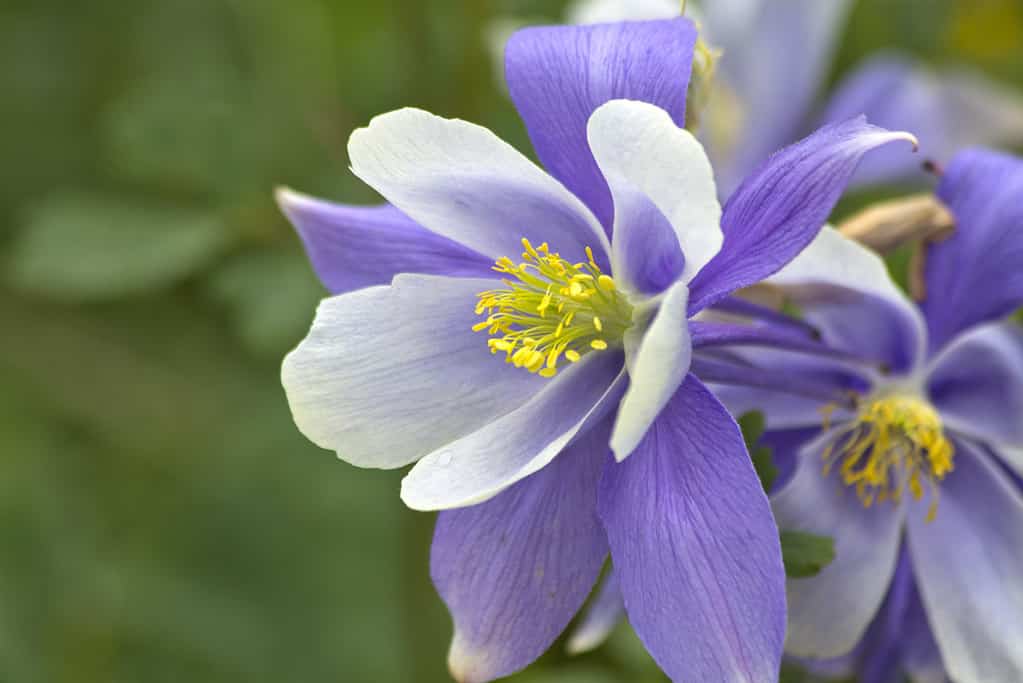
These stunning flowers do very well in USDA hardiness zones 3 through 9, especially in Colorado.
©blueeyeddesigns08/iStock via Getty Images
Columbine flowers, scientifically known as Aquilegia, are vibrant and iconic blooms that thrive in the unique climate of Colorado. These wildflowers are particularly well-suited to the Centennial State due to their adaptability to its challenging conditions. Colorado’s elevation, varied terrain, and temperate climate provide an ideal environment for columbines to flourish.
Columbines typically do best when planted in the early spring or late fall, as they prefer cooler temperatures. In Colorado, where winters can be harsh and summers are warm, planting in the spring is often recommended. This allows the plants to establish their roots before the heat of summer arrives.
These distinctive flowers are known for their distinctive appearance. Columbines boast a bell-shaped bloom with two contrasting colors – often a combination of blue, purple, pink, white, or yellow. They have delicate, fern-like foliage that adds an elegant touch to gardens and landscapes. These unique features make columbines a favorite among gardeners and nature enthusiasts.
Beyond their aesthetic appeal, columbine flowers have practical uses. They benefit the local ecology by providing nectar for pollinators like hummingbirds and bees. Some Native American communities even made therapeutic use of the herb. The columbine is the official flower of Colorado and is a symbol of the state’s rugged beauty and hardy spirit.
2. Blue Flax

The delicate and aesthetically pleasing blue flax flower will grow five periwinkle-colored petals per flower.
©iStock.com/Marcasia
Blue flax flowers, scientifically known as Linum perenne, are enchanting wildflowers that thrive in the diverse landscape of Colorado. These perennials are widespread in Colorado gardens and parks because they thrive in the state’s varied climate and soil types.
The blue flax blossoms of Colorado are well-known for their resilience amid the state’s dry environment and altitude. They can survive the many dry spells in the state because their taproots extend deep into the ground and reach the water there. They also do particularly well in the sandy, well-drained soils typical of most of Colorado.
Planting blue flax flowers in Colorado in the early spring or late fall yields the finest results. This timing coincides with the cooler temperatures that these flowers prefer, helping them establish strong roots before the heat of summer arrives.
Blue flax flowers exhibit a delicate yet captivating appearance. They produce slender, wiry stems covered in slender, sky-blue petals that resemble open saucers. Each flower lasts for only a day, but the plants produce an abundance of blooms throughout their flowering season, creating a sea of brilliant blue in gardens and meadows.
Blue flax flowers are valuable for their role in supporting pollinators like bees and butterflies. These flowers provide nectar and pollen, contributing to the health of local ecosystems. Some gardeners also appreciate them as a low-maintenance ornamental addition to their landscapes.
3. Black-Eyed Susan

Many Black-eyed Susans are commonly found in Colorado and have traditionally been used to treat colds, sores, and even snake bites.
©LauraTabor/iStock via Getty Images
Black-eyed Susan flowers, scientifically known as Rudbeckia hirta, are resilient and vibrant perennials that thrive in the diverse climate of Colorado. Their adaptability to the state’s conditions makes them a popular choice among gardeners and a common sight in Colorado’s landscapes.
Colorado’s varying elevations and temperatures provide an ideal environment for black-eyed Susans. The temperature in this state can vary greatly, from cold and snowy winters to scorching and dry summers, yet these flowers can withstand it all with ease. They are a dependable option for Colorado gardening because of their resistance to drought and cold.
For optimal growth, it is recommended to plant black-eyed Susan flowers in the early spring or late summer in Colorado. This timing allows the plants to establish their roots before the heat of summer or the frost of winter arrives. They thrive in well-drained soil with plenty of sunlight, which is abundant in many parts of Colorado.
Black-eyed Susan flowers are known for their striking appearance. They feature bright yellow or orange petals that surround a dark brown or black central cone, creating a distinctive “black-eyed” appearance. These daisy-like blooms can reach heights of two to three feet and provide a burst of color to gardens and meadows.
Beyond their visual appeal, black-eyed Susans serve various purposes. They help maintain ecosystem vitality by providing nectar for pollinators like bees and butterflies. These flowers are frequently used in landscaping to bring splashes of color to gardens and as cut flowers for floral arrangements.
4. Russian Sage
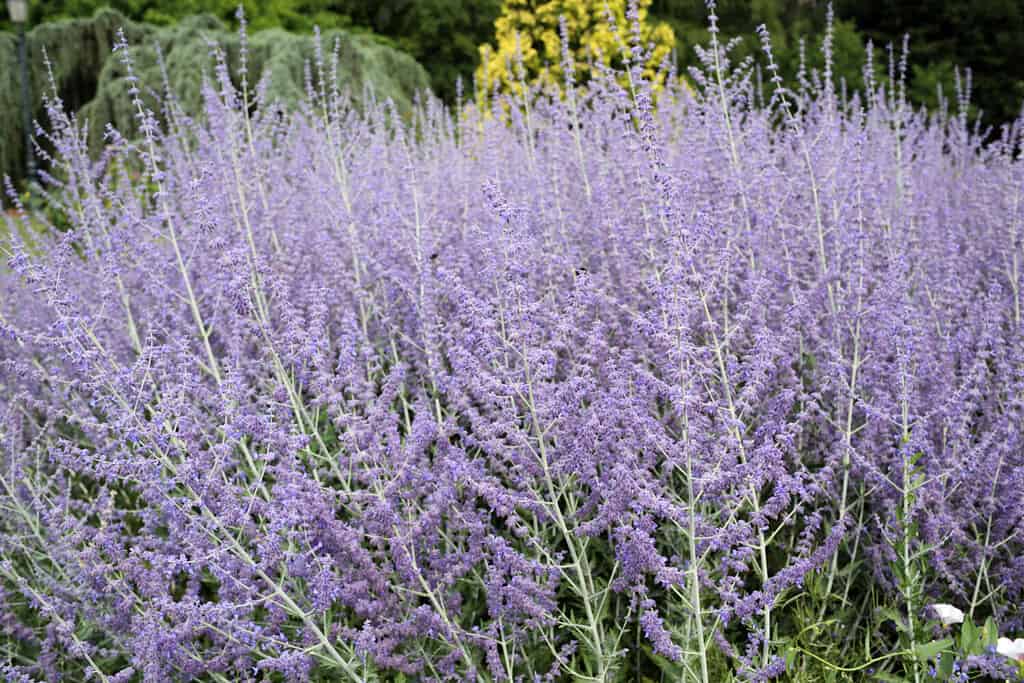
A common sight in Colorado, the Russian sage plant with grow well in hardiness zones 4, 5, 6, 7, 8, and 9.
©loflo69/Shutterstock.com
Russian sage, scientifically known as Perovskia atriplicifolia, is a popular and hardy perennial that thrives in the diverse climate of Colorado. These drought-resistant plants are often used in California landscaping because they thrive in the state’s climate.
The resilience of Russian sage is a major contributor to its widespread success in Colorado. These plants fare particularly well in the dry conditions and wide range of altitudes found in Colorado. Tolerant of both harsh winters and scorching summers, as well as dry, well-drained soil, they are a great option for Colorado gardens.
For optimal growth, it is best to plant Russian sage in the early spring or early fall in Colorado. These planting times coincide with milder temperatures, allowing the plants to establish their roots before the extreme weather of summer or winter sets in. They prefer full sun exposure, which is abundant in most parts of the state.
Russian sage flowers are known for their distinctive appearance. They produce tall, slender stems covered in silvery-gray foliage and adorned with small, tubular, lavender-blue flowers. These blooms create a graceful, wispy appearance that adds a touch of elegance to gardens and landscapes.
Russian sage serves multiple purposes. They are highly attractive to pollinators like bees and butterflies, making them a valuable addition to gardens that support local ecosystems. In landscaping, Russian sage is often used to create borders, provide texture, and add a pop of color to gardens. Additionally, the plant’s aromatic foliage is sometimes used in herbal teas and potpourri.
5. Oriental Poppy

All Oriental poppies come in a wide range of colors, from white (pictured) to red to pink to orange.
©Ole Schoener/Shutterstock.com
Oriental poppies, scientifically known as Papaver orientale, are robust perennials that thrive in the diverse climate of Colorado. These colorful blooms are a popular option among Colorado gardeners because they thrive in the state’s varied climate and altitude.
One reason why Oriental poppies thrive so well in Colorado is their ability to adjust to the state’s varied altitudes and environment. These perennials can withstand the harsh conditions of the state’s winters and summers with ease. They like the state’s higher altitudes and thrive in regions with well-drained soil.
Planting Oriental poppies in Colorado in the spring or fall is recommended for optimal growth and blooming. These planting times coincide with milder temperatures and allow the plants to establish their roots before the extreme weather of summer or winter arrives. Oriental poppies thrive in locations with plenty of sunlight, which is abundant in most parts of Colorado.
The beauty of Oriental poppies has long been recognized. They have papery petals and appear in a variety of bright hues like red, orange, pink, and white. The flowers are enormous and spectacular. These tall, colorful blooms may stand anywhere from two to four feet tall, bringing a dramatic touch to any outdoor space.
Oriental poppies also serve several additional purposes. They are attractive to pollinators like bees and butterflies, contributing to the biodiversity of local ecosystems. Gardeners often use these flowers as focal points in their landscapes or as cut flowers in floral arrangements due to their striking beauty. Additionally, some parts of the Oriental poppy plant have been used in traditional herbal medicine for their potential therapeutic properties.
6. Sunflowers

Most sunflowers can be grown for their visual appeal as well as their seeds.
©iStock.com/Katie Simmons
Sunflowers, scientifically known as Helianthus annuus, are iconic and resilient flowers that thrive in the diverse climate of Colorado. These bright flowers thrive in the dry, sunny climate of Colorado, making them a popular option for gardeners and a representation of the state’s flora and fauna.
Sunflowers thrive in Colorado because they can adjust to the state’s varied environment. Sunflowers are recognized for their resilience, making them a good choice for Colorado’s varied altitudes and climates. They can survive in a variety of climates, from the freezing winters to the scorching summers. They adapt well to the state’s climate and landscape, flourishing in the state’s well-drained soils and basking in the sun.
Planting sunflowers in Colorado is best done in the late spring or early summer when the earth is at its warmest. This timetable permits the plants to take full advantage of the summer’s abundant daylight. They thrive in full sun, which is abundant across the state.
Sunflowers are recognizable by their towering stems crowned with large, yellow, or orange blossoms. The flowers consist of a central disk filled with tiny florets, surrounded by petal-like ray florets. These sunny blooms can grow to impressive heights, often reaching six to 10 feet or more, making them a striking addition to gardens and fields.
Beyond their summery looks, sunflowers serve various purposes. Bees and other pollinators greatly benefit from them since they provide a rich food source of nectar and pollen. Additionally, sunflower seeds are gathered for several applications, such as a healthy snack, in baking, and for the creation of sunflower oil. Sunflowers are not only a beautiful addition to any garden, but also a sign of optimism and enthusiasm.
7. Sedum
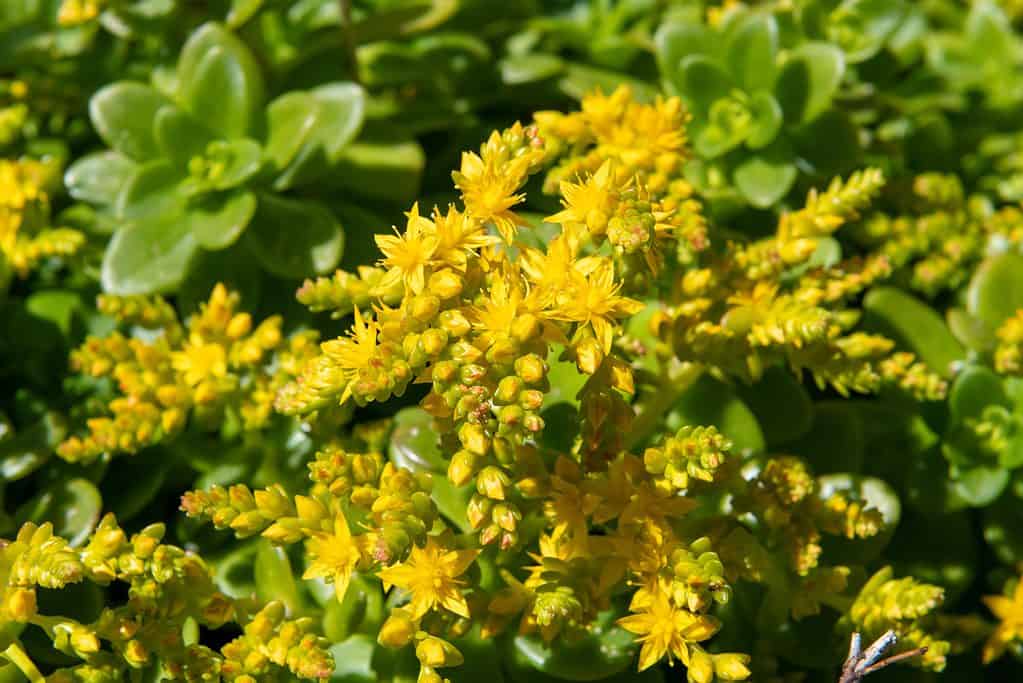
There are quite a few different flowers in this genus, but most Sedums will grow well in hardiness zones 3 through 11.
©Tom Meaker/Shutterstock.com
The succulent genus Sedum shows remarkable flexibility and persistence in Colorado’s varied environment. Because of how well they adapt to the state’s climate, these plants are frequently used by gardeners and landscapers who want low-maintenance, aesthetically pleasing vegetation.
Sedums, however, thrive in the wide range of altitudes, bright sunshine, and variable temperatures that characterize Colorado. Because of their resistance to dry conditions, they thrive in the sunny state of Colorado. They can survive in dry environments thanks to the large amounts of water they can store in their thick leaves.
Planting sedums in Colorado is most successful in the spring or early summer when the soil has warmed up. This timing allows the plants to establish their roots before the scorching summer heat sets in. They thrive in well-drained soil and are particularly well-adapted to the well-drained, sandy soils prevalent in many parts of Colorado.
Some sedum variants have blue-green leaves, purple leaves, or variegated leaves, among other leaf colors and forms. They bloom in the late summer or early fall with star-shaped blooms in white, pink, or crimson. Pollinators such as bees and butterflies will like visiting these blooms.
In landscaping, sedums serve several purposes: as ground cover, erosion prevention, and decorative accents. Their low-maintenance nature makes them a favored choice for xeriscaping, rock gardens, and green roofs. Sedums are also known for their air-purifying qualities and are used in green building initiatives. Some sedum species have medicinal properties and are used in traditional herbal medicine for various ailments.
8. Coneflower
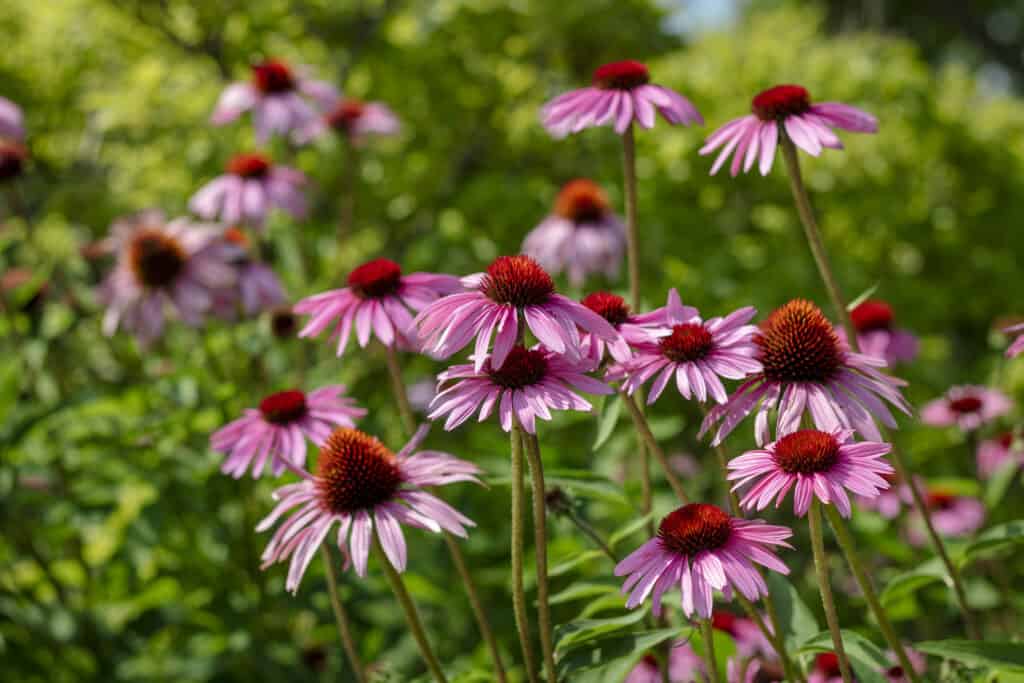
Coneflowers can add a stunning touch of color to any Colorado garden.
©iStock.com/Air Footy
Echinacea, more often known as coneflowers, are robust and colorful perennials that flourish well in Colorado’s varied environment. As a result of its adaptability to Colorado’s climate, these beautiful flowers are frequently grown in the state’s gardens and meadows.
Coneflowers’ widespread success in Colorado can be attributed in large part to their ability to thrive in the state’s varied environment. Colorado’s varying elevations, intense sunlight, and fluctuating temperatures present a challenging environment, but coneflowers are remarkably resilient. They can tolerate both the cold winters and hot, arid summers that Colorado experiences. They thrive in the state’s well-drained soil and plentiful sunshine, both of which they appreciate.
Coneflowers should be planted in the spring in Colorado when the ground has thawed and temperatures have dropped. The plants can have their feet set down before the summer heat hits. They require lots of sunlight, which is readily available across the state.
Coneflowers are easily recognizable by their striking appearance. Their name comes from the huge daisy-like blooms they produce, which have a high, cone-shaped core. They have the potential to reach heights of three to four feet, making them an impressive addition to any garden.
The presence of coneflowers in gardens is beneficial because they encourage the presence of pollinators like bees and butterflies. In addition, many use coneflower extracts for their purported medical and immune-enhancing effects.
Summary of the Best Flowers to Plant in Colorado + More
| # | Flowers | Sunlight Needs |
|---|---|---|
| 1 | Columbine | Partial to full shade |
| 2 | Blue Flax | Full sun |
| 3 | Black-Eyed Susan | Full sun to partial shade |
| 4 | Russian Sage | Full sun |
| 5 | Oriental Poppy | Full sun |
| 6 | Sunflowers | Full sun |
| 7 | Sedum | Full sun to light shade |
| 8 | Coneflower | Full sun to light shade |
| 9 | Rocky Mountain Penstemon | Full sun to partial shade |
| 10 | Blanket Flower | Full sun |
| 11 | Liatris | Full sun |
| 12 | Tiger Lily | Partial shade to full sun |
| 13 | Gaillardia | Full sun |
| 14 | Yarrow | Full sun |
| 15 | Lupine | Full sun to light shade |
| 16 | Blanket Flower | Full sun |
| 17 | Bee Balm | Full sun to partial shade |
| 18 | Iris | Full sun to partial shade |
| 19 | Tall Bluebell | Full sun |
| 20 | Showy Milkweed | Full sun |
Thank you for reading! Have some feedback for us? Contact the AZ Animals editorial team.

